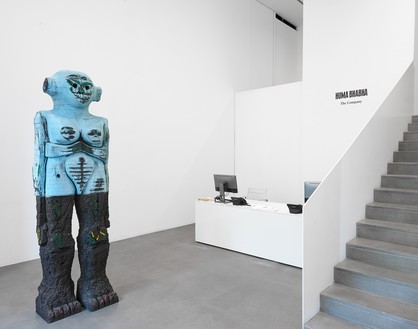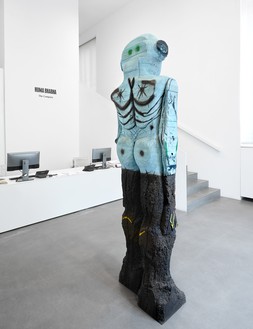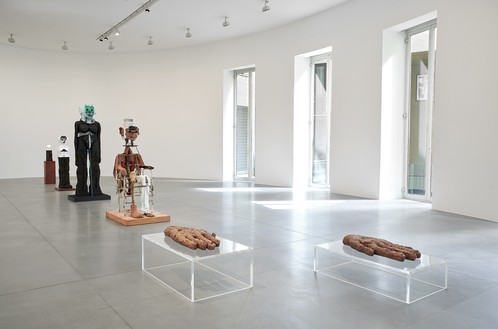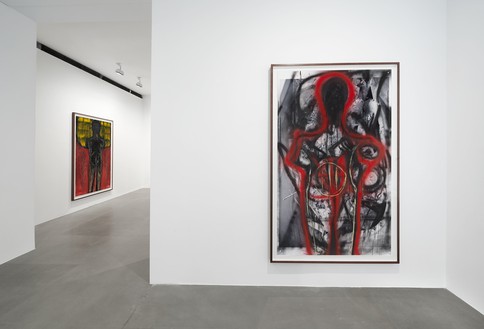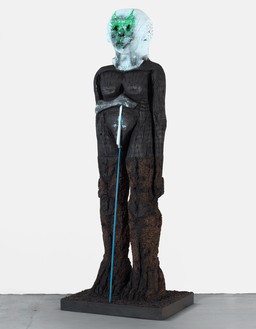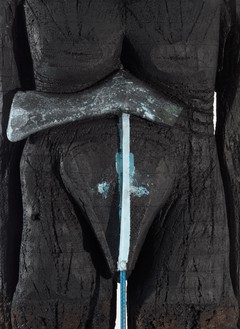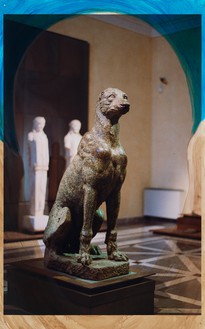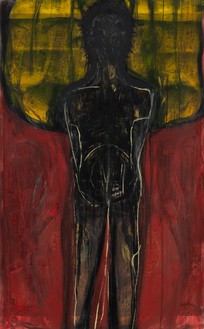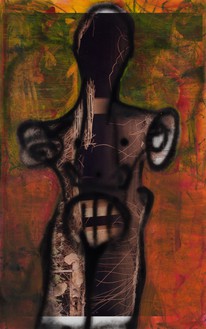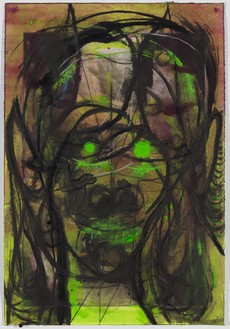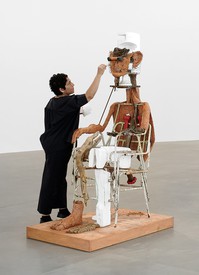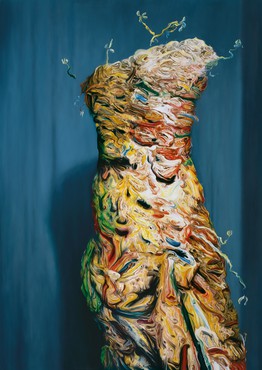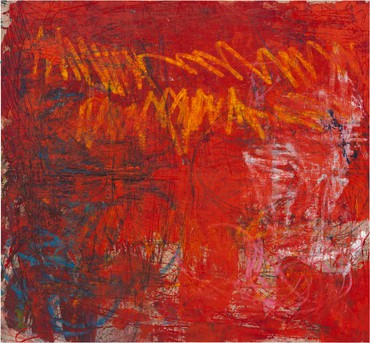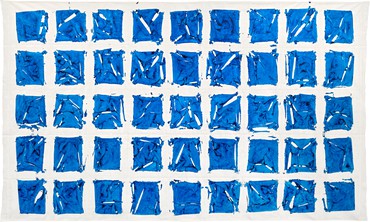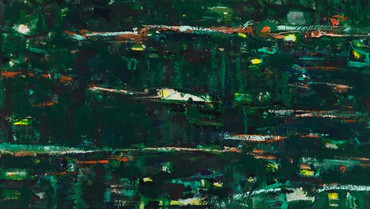Extended through January 4, 2020
About
There is so much physical destruction happening in different parts of the world, to the extent that many functioning cities look like archeological digs. One of the ways I like to approach the past is in a cinematic way, reimagining the past and projecting towards the future just as movies often do.
—Huma Bhabha
Gagosian is pleased to present The Company, new sculptures and drawings by Huma Bhabha. This is her first exhibition in Rome.
In expressive drawings on photographs as well as figurative sculptures carved from cork and Styrofoam, assembled from refuse and clay, or cast in bronze, Bhabha probes the tensions between time, memory, and displacement. References to science-fiction, archeological ruins, Roman antiquities, and postwar abstraction combine as she transforms the human figure into grimacing totems that are both unsettling and darkly humorous.
The Company is inspired in part by “The Lottery in Babylon” (1941), a short story by Jorge Luis Borges in which a fictional society is taken over by a pervasive lottery system that doles out both rewards and punishments. The lottery is purportedly run by the Company, a secret, perhaps nonexistent body determining peoples’ fates. Bhabha’s procession of sculptures makes visible the power of this unseen Company. It comprises a pair of large, disembodied hands floating atop transparent plinths; a seated figure; and several standing figures of varying scale. Drawings on photographs echo these forms and characters, which could have come from a distant realm of the future just as easily as from a lost civilization. The standing figures are carved from stacks of dark cork—which emits an earthy, acrid odor—and its technical inverse, Styrofoam. These materials appear to be hard and dense, like eroded stone or freshly quarried marble, but they are lightweight and soft, allowing Bhabha to carve quickly and spontaneously without over-refining. The sculptural process thus becomes a sort of embodied stream of consciousness from which alien monsters, fertility goddesses, and Greek kouroi emerge.
C’è così tanta devastazione fisica in diverse parti del mondo che molte città vive sembrano degli scavi archeologici. Uno dei modi con cui amo avvicinarmi al passato è quello cinematografico, reimmaginandolo e proiettandolo verso il futuro come spesso solo il cinema fa.
—Huma Bhabha
Gagosian è lieta di presentare The Company, una mostra di nuove sculture e disegni di Huma Bhabha. È la prima volta che l’artista pakistana espone a Roma.
Tramite espressivi disegni su fotografia e sculture figurative intagliate nel sughero e nello Styrofoam, realizzate con materiali di scarto e argilla, o fuse in bronzo, Bhabha esplora le tensioni tra tempo, memoria, e sradicamento. Tra fantascienza, resti archeologici, rovine romane e utopia postbellica l’artista trasforma la figura umana in totem ghignanti, allo stesso tempo figure inquietanti e sinistramente divertenti.
The Company è in parte ispirata a “La Lotteria a Babilonia” (1941), un breve racconto di Jorge Luis Borges nel quale una società immaginaria è sopraffatta dal sistema di una lotteria incombente che dispensa ricompense e punizioni. La lotteria è presumibilmente diretta dalla Compagnia, un segreto, forse inesistente organismo che decide i destini delle persone. La processione di sculture di Bhabha svela il potere di questa Compagnia misteriosa. Questa comprende un paio di grandi mani disarticolate dal corpo che sembrano fluttuare su piedistalli trasparenti; una figura seduta; e numerose figure in piedi di diverse dimensioni. I disegni su fotografia richiamano questi personaggi, che potrebbero provenire da un lontano regno futuristico così come da una civiltà perduta. Le figure in piedi sono intagliate in pile di sughero scuro, emanante un acre odore di terra, e dal suo opposto tecnico, lo Styrofoam. Questi materiali, dall’aspetto duro e compatto, come pietre erose e marmi appena estratti, sono in realtà leggeri e morbidi e permettono a Bhabha di scolpire in maniera rapida e spontanea senza rifiniture. Il processo scultoreo diventa così una sorta di flusso di coscienza dal quale emergono mostri alieni, divinità della fertilità e kouroi greci.
I visi delle sculture di Bhabha simili a maschere sono allo stesso tempo maestosi e conturbanti. Dipinti in sorprendenti toni pastello—azzurro, malva, rosa e verde—richiamano i graffiti, nei quali la sporcizia urbana si mescola a interventi pittorici dai colori brillanti. Con i loro lineamenti folli da cartone animato rafforzati da un profetico bipedismo, le sculture di Bhabha sembrano sia prendere in giro che mettere in guardia, in quanto riflessioni sul e testimoni dell’orgoglio e del potere umano, della venerazione e dell’iconoclastia.
Accostando cicatrici di guerra, il colonialismo e i traumi ad allusioni ad eventi attuali e ai media di massa, Bhabha ha a lungo sostenuto che il mondo sia un’apocalisse, creata sia dall’uomo che dalla natura: le sue sculture saccheggiate sembrano essere testimoni di una certa catastrofe alla quale sono riuscite a sopravvivere per raccontarne la storia. Come un faraone sul trono o un cyborg colpito da una pioggia di schegge di proiettili, una figura seduta è realizzata con argilla giallastra compressa in rete metallica, frammenti di Styrofoam macchiati, ossi giocattolo per cani e sedie arruginite provenienti da Karachi, la città natale di Bhabha, intrappolata in un fuoco incrociato di conflitti intestini e internazionali.
Nei disegni di grande formato di Bhabha, figure umane e non umane abitano lo spazio condiviso da fotografia, collage e gesti pittorici: i loro visi eterogenei e le forme indistinte sembrano infestare paesaggi, strade cittadine e siti architettonici. In uno di questi, un arco blu e beige interferisce su una fotografia che Bhabha ha scattato a Roma, ai Musei Capitolini, ad un’antica statua di un cane, con due kouroi bianchi che incombono sullo sfondo.
In occasione della mostra, la Galleria Nazionale d’Arte Moderna e Contemporanea a Roma ospita l’artista in conversazione con Cristiana Perrella, direttrice del Centro per l’Arte Contemporanea Luigi Pecci di Prato, il 18 settembre alle 18.00. La conversazione, aperta al pubblico, si terrà in inglese.
#HumaBhabha
Artist
News
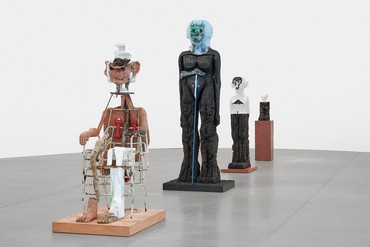
Tour
Huma Bhabha
The Company
Thursday, October 24, 2019, 3pm
Gagosian, Rome
Gagosian’s Manuela Cuccuru will lead a tour of the exhibition Huma Bhabha: The Company at Gagosian, Rome, on the occasion of Rome Art Week. This show features new expressive drawings on photographs as well as figurative sculptures carved from cork and Styrofoam, assembled from refuse and clay, or cast in bronze. Probing the tensions between time, memory, and displacement, Bhabha combines references to science fiction, archeological ruins, Roman antiquities, and postwar abstraction as she transforms the human figure into grimacing totems that are both unsettling and darkly humorous. To attend the free event, register at romeartweek.com.
Installation view, Huma Bhabha: The Company, Gagosian, Rome, September 19–December 14, 2019. Artwork © Huma Bhabha
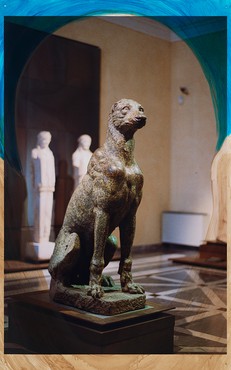
In Conversation
Huma Bhabha
Cristiana Perrella
Wednesday, September 18, 2019, 6pm
Galleria Nazionale d’Arte Moderna e Contemporanea, Rome
lagallerianazionale.com
On the occasion of Huma Bhabha’s first exhibition in Rome, the Galleria Nazionale d’Arte Moderna e Contemporanea will host a conversation between the artist and Cristiana Perrella, director of the Centro per l’Arte Contemporanea Luigi Pecci in Prato, Italy. The show features expressive drawings on photographs as well as figurative sculptures carved from cork and Styrofoam, assembled from refuse and clay, or cast in bronze, through which Bhabha probes the tensions between time, memory, and displacement. References to science-fiction, archeological ruins, Roman antiquities, and postwar abstraction combine as she transforms the human figure into grimacing totems that are both unsettling and darkly humorous. The event is free and open to the public.
Huma Bhabha, Untitled, 2019 © Huma Bhabha
